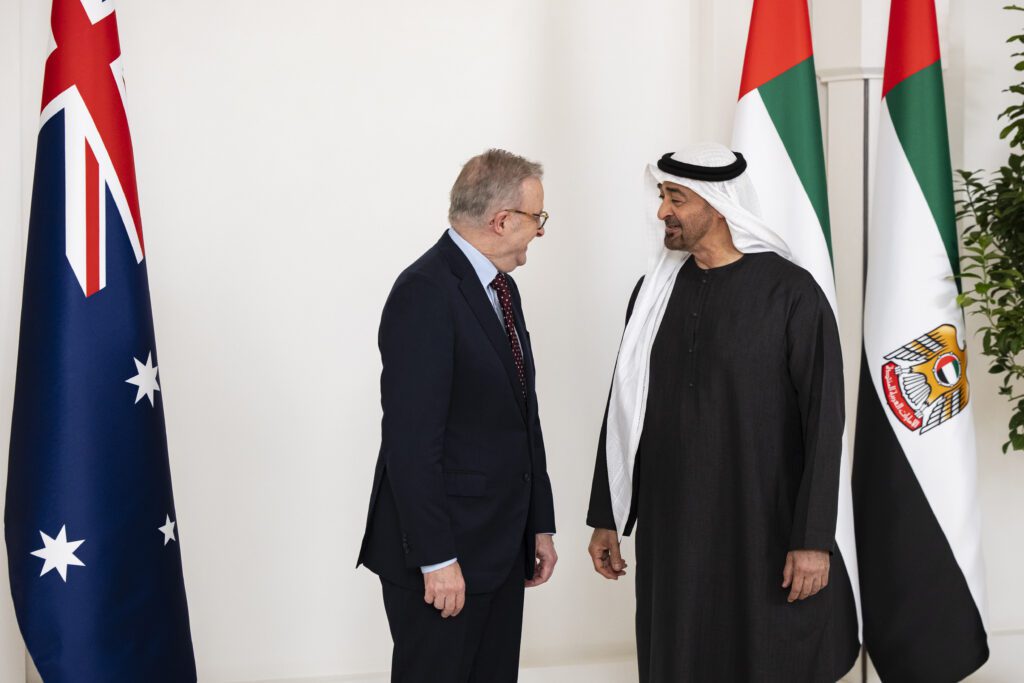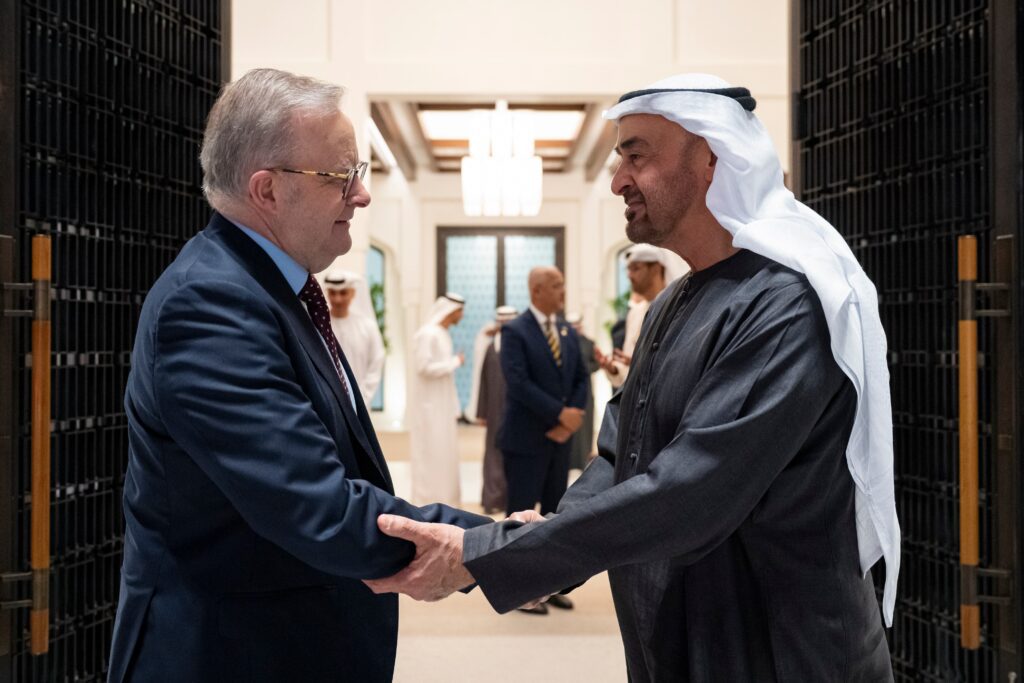The UAE-Australia CEPA has officially come into force, marking a historic milestone in bilateral economic relations. This landmark agreement is set to transform trade, investment, and economic collaboration between the two nations. The Comprehensive Economic Partnership Agreement CEPA is projected to more than double the current annual trade from 4.2 billion dollars to over 10 billion dollars by 2032. Beyond numbers, it reflects a strategic vision to strengthen economic ties, foster innovation, and open new opportunities across multiple sectors.
What Is the UAE-Australia CEPA?
The UAE-Australia CEPA is a comprehensive trade agreement designed to enhance commercial, investment, and economic cooperation. It is the first agreement of its kind between Australia and a Middle Eastern country, making it a milestone for Australian trade diversification. The CEPA provides a structured framework that eliminates tariffs on nearly all Australian exports to the UAE, creating new avenues for businesses to expand their reach.
For Australian exporters, this agreement is a significant step forward. Agricultural products like meat, dairy, grains, and minerals will now enjoy preferential access to the UAE market. This access ensures that Australian products can compete more effectively in the region, benefiting farmers, producers, and exporters alike.

Key Benefits of the UAE-Australia CEPA
The CEPA offers a wide range of benefits for both countries, creating opportunities for trade expansion, investment, and economic collaboration.
Elimination of Tariffs
One of the most important features of the agreement is the removal of tariffs on almost all Australian exports. This means Australian businesses can sell products in the UAE at more competitive prices, making them more attractive to consumers and importers. Farmers and food producers are expected to experience significant cost savings, while manufacturers can explore new markets with reduced financial barriers.

Enhanced Market Access
The UAE serves as a strategic hub for the broader Middle East and North Africa. By establishing preferential access to this market, Australian businesses can leverage the UAE as a gateway to neighboring countries. This access is particularly valuable for industries seeking growth in the Gulf region and the wider Middle East, where demand for high-quality Australian products continues to rise.
Boost to Investment Opportunities
Beyond trade, the CEPA encourages investment across multiple sectors, including renewable energy, technology, and infrastructure. Both countries aim to create an environment that supports innovation and economic growth. The agreement enables Australian investors to explore projects in the UAE, while UAE investors gain easier access to opportunities in Australia. This two-way investment flow is expected to strengthen economic ties and promote mutual growth.
Support for Key Industries
Agriculture, food processing, and mining are among the sectors that stand to gain the most. By reducing trade barriers, the CEPA enables these industries to expand their operations and reach new markets. In addition, emerging sectors like clean energy, technology, and logistics can benefit from enhanced cooperation, opening doors to joint ventures and innovative projects.
The Strategic Importance of the CEPA
The UAE-Australia CEPA is more than just a trade agreement; it represents a strategic partnership. The UAE is one of Australia’s largest trading partners in the Middle East, and the CEPA solidifies this relationship. By creating a predictable and transparent trade framework, both countries can plan long-term strategies to grow their economies.
This agreement also positions Australia to diversify its trade relationships beyond traditional partners such as China, the United States, and Japan. In the case of the UAE, the partnership provides access to a dynamic and rapidly growing regional economy that serves as a gateway to other Gulf countries. For the UAE, Australia represents a source of high-quality goods and services, along with opportunities for investment and collaboration in sectors like agriculture, mining, and renewable energy.
Projected Impact on Bilateral Trade
The CEPA is expected to drive a significant increase in bilateral trade over the coming years. Non-oil trade between the two nations has already been on an upward trajectory, showing growth in sectors like agriculture, education, technology, and professional services. With the agreement now in place, both countries aim to more than double trade volumes by 2032, reaching the 10 billion dollar mark.
Australian exporters stand to benefit from immediate tariff reductions, while UAE businesses can explore opportunities in sectors such as renewable energy, logistics, and technology in Australia. This increase in trade not only supports economic growth but also strengthens employment, innovation, and competitiveness in both countries.
Opportunities for Businesses
The CEPA opens a wide array of opportunities for businesses in both nations. For Australian companies, it provides the chance to access a rapidly growing market with a high demand for quality products. For UAE companies, it offers avenues for investment in key Australian sectors.
Businesses in agriculture can expand exports of meat, dairy, grains, and other food products. Manufacturing companies can explore markets for machinery, chemicals, and other industrial products. In the technology sector, joint ventures and partnerships are expected to grow, as the agreement encourages collaboration in digital solutions, innovation, and infrastructure development.

Enhancing Trade in Agriculture
Agriculture is a cornerstone of Australian exports, and the CEPA offers substantial advantages in this sector. With reduced tariffs, farmers and food producers can increase their market share in the UAE. This expansion will not only generate higher revenues but also foster stronger partnerships between agricultural organizations, distributors, and retailers.
In addition, the agreement encourages knowledge exchange in areas such as sustainable farming practices, food safety standards, and supply chain efficiency. By working together, both nations can improve production quality, reduce waste, and enhance the sustainability of the agricultural sector.
Technological and Infrastructure Collaboration
The CEPA is not limited to trade in goods. It also emphasizes collaboration in technology and infrastructure. Both countries are poised to invest in smart city projects, renewable energy development, and technological innovation. This collaboration will create opportunities for joint research, development projects, and knowledge sharing, strengthening both economies for the future.
Infrastructure development, including ports, transport networks, and logistics hubs, will benefit from increased cooperation. This will not only improve trade efficiency but also create a more resilient supply chain for goods moving between the two countries.
Renewable Energy and Sustainability
A significant aspect of the CEPA is its potential impact on renewable energy and sustainability. Both the UAE and Australia have set ambitious goals for reducing carbon emissions and transitioning to clean energy. The agreement encourages collaboration in solar, wind, and other renewable energy projects.
Australian expertise in clean energy technologies can support the UAE’s sustainability objectives, while the UAE’s investment capabilities can help fund large-scale projects in Australia. This partnership fosters innovation, reduces environmental impact, and strengthens both nations’ positions in the global green economy.
Education and Skills Development
The UAE-Australia CEPA also opens doors for collaboration in education and skills development. Australian educational institutions can attract more students from the UAE, while UAE students gain access to quality programs and courses. This exchange promotes knowledge sharing, cultural understanding, and workforce development.
Furthermore, vocational training programs, internships, and professional development initiatives can be expanded, supporting skills transfer in sectors such as technology, engineering, agriculture, and healthcare. This focus on human capital complements the agreement’s economic and trade objectives.

The Role of SMEs in CEPA
Small and medium-sized enterprises are expected to benefit significantly from the CEPA. By reducing barriers to entry, the agreement allows SMEs to access new markets with lower costs and less regulatory complexity.
Australian SMEs can explore opportunities in food and beverage exports, health products, technology services, and education-related solutions. UAE SMEs can invest in joint ventures, technology collaborations, and infrastructure projects. Supporting SMEs not only promotes economic diversity but also encourages innovation and competitiveness.
Future Prospects
The CEPA sets the stage for a long-term strategic partnership between the UAE and Australia. By providing a stable, transparent, and mutually beneficial trade framework, both nations can pursue ambitious economic goals.
Over the next decade, the CEPA is expected to facilitate:
- Expansion of bilateral trade to over 10 billion dollars by 2032
- Growth in investment across renewable energy, infrastructure, and technology
- Strengthening of strategic ties in agriculture, manufacturing, and education
- Development of joint ventures and collaborations in emerging sectors
- Creation of new employment opportunities and skills development programs
This agreement reflects a shared vision for growth, innovation, and sustainability. It positions both countries to capitalize on regional and global opportunities while fostering a strong, mutually beneficial economic partnership.
Conclusion
The UAE-Australia CEPA represents a new chapter in economic cooperation, trade, and investment. It is not only about numbers but also about strengthening strategic ties, fostering innovation, and creating opportunities for businesses and communities. With the agreement now in force, both countries are poised to benefit from increased trade, investment, and collaboration across multiple sectors.
The CEPA demonstrates a commitment to long-term economic growth, diversification, and sustainability. As trade volumes grow and opportunities expand, the partnership between the UAE and Australia is expected to thrive, creating a foundation for prosperity that extends well beyond 2032.
By unlocking new markets, promoting innovation, and supporting businesses of all sizes, the UAE-Australia CEPA is set to become a cornerstone of bilateral economic success and a model for regional cooperation in the years to come.
Do follow UAE Stories on Instagram
Read Next – SolitAir Dubai Marks First Year with 30 Global South Cargo Routes














